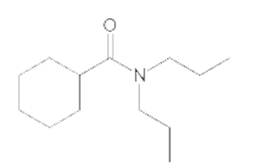
Concept explainers
(a)
Interpretation:
The products formed when the following amide is treated with H2O and NaOH should be determined:
Concept Introduction:
(b)
Interpretation:
The products formed when the following amide is treated with H2O and NaOH should be determined:
Concept Introduction:
Functional groups are the groups of atoms or atoms which are bonded with parent carbon chain in the organic molecule and are responsible for the physical and chemical properties of the compound. In organic chemistry, there are different functional groups such as carboxylic acid, alcohol, ester, or amide.
Amines are the organic compounds with general chemical formula of R-NH2 or R-NH-R whereas carboxylic acids are the organic molecules with R-COOH as general chemical formula.
(c)
Interpretation:
The products formed when the following amide is treated with H2O and NaOH should be determined:

Concept Introduction:
Functional groups are the groups of atoms or atoms which are bonded with parent carbon chain in the organic molecule and are responsible for the physical and chemical properties of the compound. In organic chemistry, there are different functional groups such as carboxylic acid, alcohol, ester, or amide.
Amines are the organic compounds with general chemical formula of R-NH2 or R-NH-R whereas carboxylic acids are the organic molecules with R-COOH as general chemical formula.
Want to see the full answer?
Check out a sample textbook solution
Chapter 17 Solutions
General, Organic, and Biological Chemistry - 4th edition
- What products are formed when all of the amide and ester bonds are hydrolyzed in each of the following compounds? Tamiu [part (a)] is the trade name of the antiviral agent oseltamivir, thought to be the most effective agent in treating inuenza. Aspartame [part (b)] is the articial sweetener used in Equal and many diet beverages. One of the products ofthis hydrolysis reaction is the amino acid phenylalanine. Infants afflicted with phenylketonuria cannot metabolize this amino acid, so it accumulates, causing mental retardation. When the affliction is identied early, a diet limiting the consumption of phenylalanine (and compounds like aspartame that are converted to it) can make a normal life possible.arrow_forwardGive the name of a carboxylic acid or carboxylate salt used in each of the following ways: a.As a soap b.As a general food preservative used to pickle vegetables c.As a preservative used in soft drinks d.As a treatment of athletes foot e.As a mold inhibitor used in bread. f.As a food additive noted for its pH buffering abilityarrow_forwardIn the 1880's, Acetanilide, sold under the name Antifebrin, was widely used as a pain reliever and fever reducer. However, it had many adverse side effects, including cyanosis as a result of methemoglobinemia. The toxic side effects were the result of a small portion of acetanilide being hydrolyzed to aniline. Acetanilide was discontinued and replaced with phenacetin. Later studies show that both acetanilide and phenacetin are metabolized to acetaminophen. This metabolite, which we know as Tylenol, is responsible for the analgesic and antipyretic properties. Part 1: Show a detailed arrow pushing mechanism of the acid catalyzed hydrolysis of acetanilide to aniline Part 2: Propose a synthesis of Acetaminophen from phenol NH NH NH Phenacetin inophen Acetanilide Attach File Browse Local Files Browse Content Collectionarrow_forward
- Methylparaben is a common preservative used in cosmetics. What carboxylic acid and alcohol are needed to synthesize methylparaben by Fischer esterifi cation?arrow_forwardWhat nitro compound, nitrile, and amide are reduced to each compound?arrow_forwardEtoposide, sold as a phosphate derivative with the trade name ofEtopophos, is used for the treatment of lung cancer, testicular cancer,and lymphomas. What products are formed when all of the acetals are hydrolyzed with aqueous acid?arrow_forward
- Draw the products formed when attached carbonyl compound reacts with the following amines: [1] CH3CH2CH2NH2; [2] (CH3CH2)2NH.arrow_forwardWhat products are formed when all of the amide and ester bonds arehydrolyzed in each of the following compounds? Tamiflu [part (a)] is the trade name of the antiviral agent oseltamivir, thought to be the most effective agent in treating influenza. Aspartame [part (b)] is the artificial sweetener used in Equal and many diet beverages. One of the products of this hydrolysis reaction is the amino acid phenylalanine. Infants afflicted with phenylketonuria cannot metabolize this amino acid, so it accumulates, causing mental retardation. When the affliction is identified early, a diet limiting the consumption of phenylalanine (and compounds like aspartame that are converted to it) can make a normal life possible.arrow_forwardWhat carbonyl compound and amine or alcohol are needed to prepare each product?arrow_forward
- Bisphenol A is widely used as a building block in polymer synthesis and is found in the polycarbonate hard plastics of reusable drink containers, DVDs, cell phones, and other consumer goods. Bisphenol A is reported to have estrogenic activity, and its widespread occurrence in our environment is a potential concern. Describe one or two biochemical experiments that could be done to compare the activity of bisphenol A with that of its estradiol, its structural relative.arrow_forwardSaponification product of butylpropanoate is: Butanoic acid and Propanoic acid B Propanol and Sodium butanoate Butanol and Propanoic acid D Butanol and sodium propanoatearrow_forwardDraw the structure for the following compounds It organic 1: 2,2 diiodo-3-pentenoic acid 2: N,N-diethylpropanamide 3: 2-pentanone 4: phenoxy benzene 5: N,N-diethylpropanamidearrow_forward
 Organic ChemistryChemistryISBN:9781305580350Author:William H. Brown, Brent L. Iverson, Eric Anslyn, Christopher S. FootePublisher:Cengage Learning
Organic ChemistryChemistryISBN:9781305580350Author:William H. Brown, Brent L. Iverson, Eric Anslyn, Christopher S. FootePublisher:Cengage Learning Chemistry for Today: General, Organic, and Bioche...ChemistryISBN:9781305960060Author:Spencer L. Seager, Michael R. Slabaugh, Maren S. HansenPublisher:Cengage Learning
Chemistry for Today: General, Organic, and Bioche...ChemistryISBN:9781305960060Author:Spencer L. Seager, Michael R. Slabaugh, Maren S. HansenPublisher:Cengage Learning Introduction to General, Organic and BiochemistryChemistryISBN:9781285869759Author:Frederick A. Bettelheim, William H. Brown, Mary K. Campbell, Shawn O. Farrell, Omar TorresPublisher:Cengage Learning
Introduction to General, Organic and BiochemistryChemistryISBN:9781285869759Author:Frederick A. Bettelheim, William H. Brown, Mary K. Campbell, Shawn O. Farrell, Omar TorresPublisher:Cengage Learning


